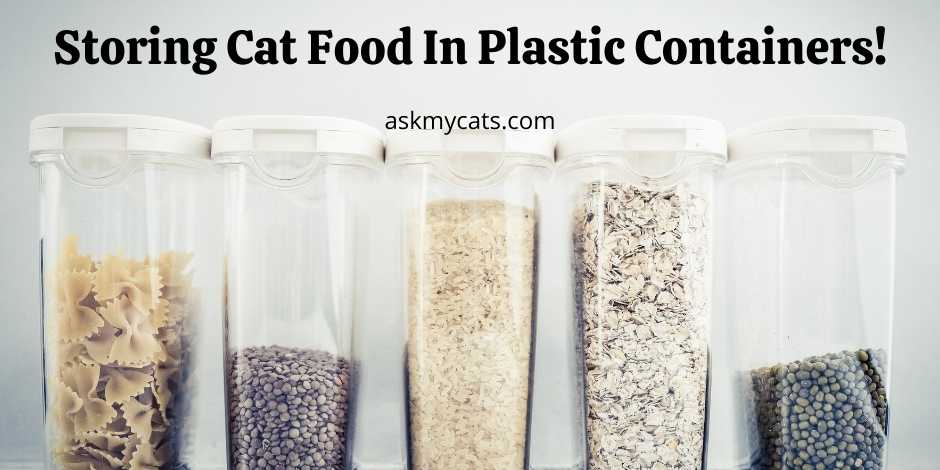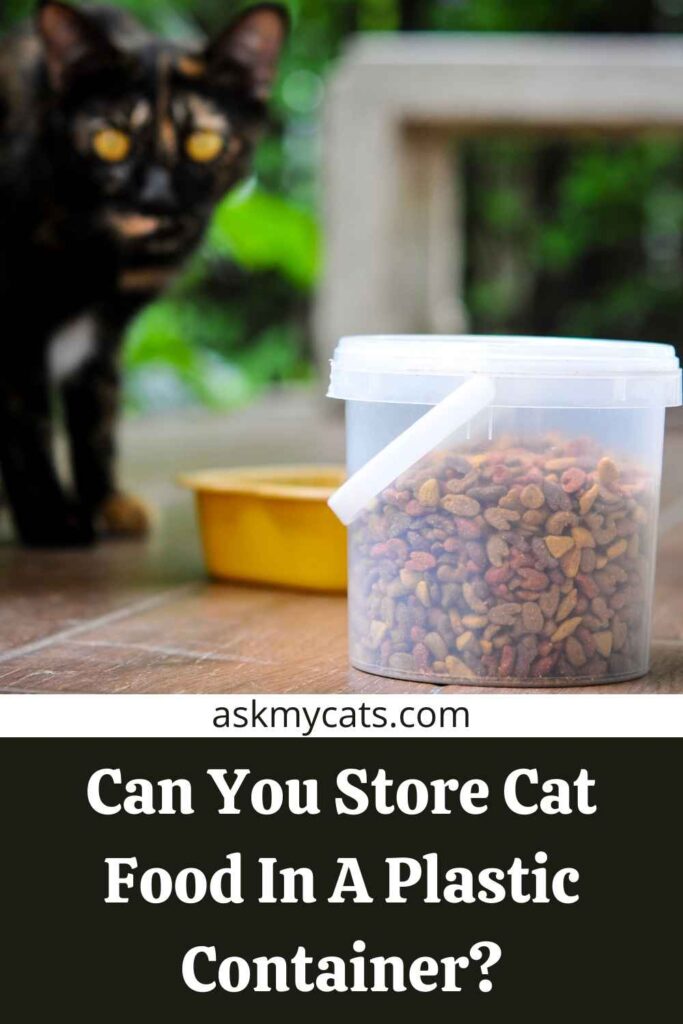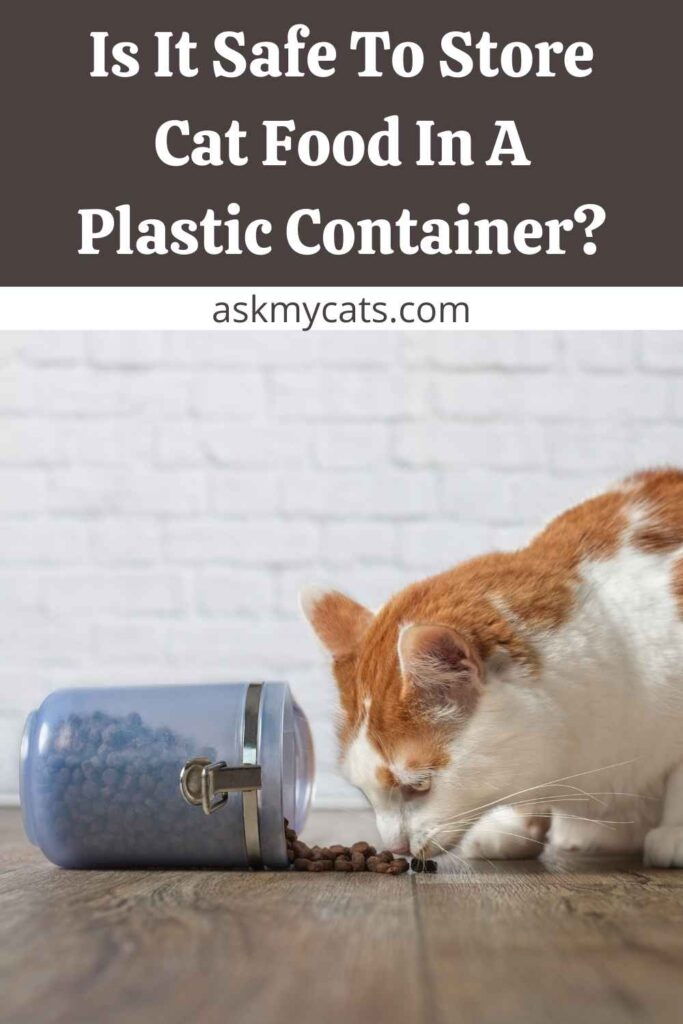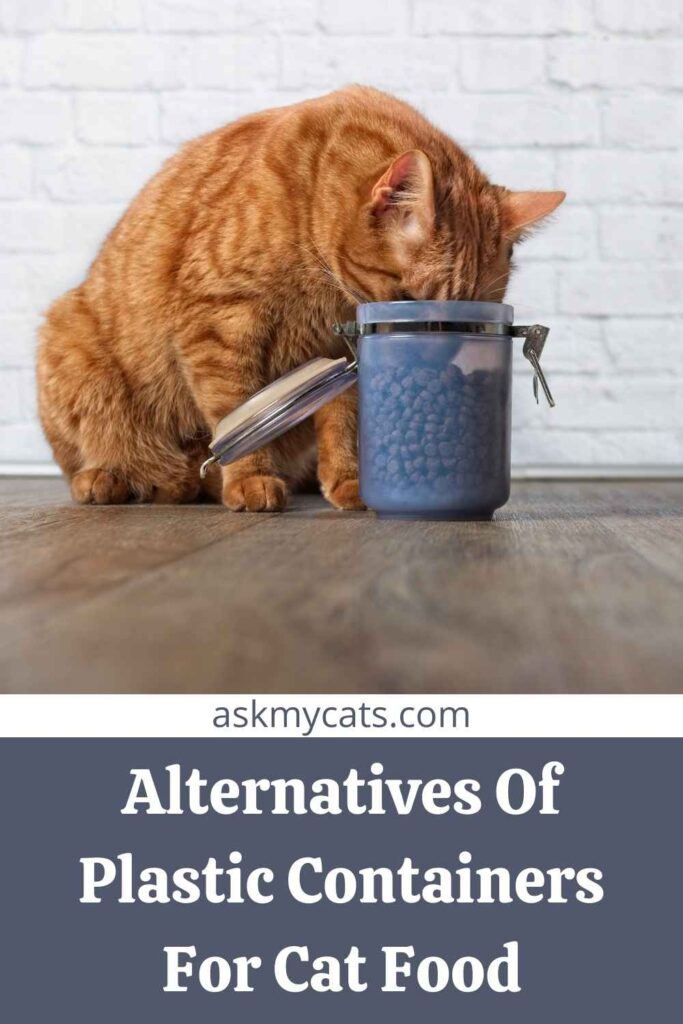The way you keep your pet’s food can cause pest infestation, food poisoning, upset tummies, and even changes in flavor and texture. Summer’s increasing heat and humidity can exacerbate these dangers.
When it comes to keeping cat food, metal or glass containers are preferable over plastic. Plastic containers and bags can impart unfavorable flavors or odors to food, and they are not always free of BPA. Plastic is very readily scratched.
If you commit to following these pet food storage instructions, you can rest certain that you’ve done everything you can to protect your pet’s food safety.
Proper storage is essential for getting your money’s worth out of everything, from dry cat food to your cat’s favorite cat treat.


Give Your Cat the Perfect Day
Get the Free Ebook!
Can You Store Cat Food In A Plastic Container?
You should never store cat food in a plastic container.

Certain plastic containers have been shown to leech toxins into food studies. BPA, a chemical found in plastic, has been demonstrated to have hormone-like, estrogenic, and cancer-causing effects.
However, BPA has been phased out of certain plastic storage containers and replaced with a substance known as bisphenol-S. (BPS). According to scientific evidence, BPS looks to be equally as dangerous (if not more so) as BPA.
In 2013, researchers at the University of Texas Medical Branch showed that even minute quantities of BPS (less than one part per trillion) could cause cellular dysfunction. Obesity, diabetes, and even cancer are possible consequences of such changes.
Everyone wants to know how to keep their food fresh for as long as possible, whether cat food or human food. Dry cat food is designed to be stored and consumed over a lengthy period. However, it frequently arrives in non-resealable packets, making it difficult for pet owners to keep fresh food.
Because dry cat food is typically packaged in non-resealable bags, pet parents must find a container to keep the food fresh. Although it isn’t quite fair, we have created a list of some decent solutions for keeping your cat’s food.
Instead of dropping pet food directly into the container, the FDA suggests keeping it in its original container. This is so that if you need to file a health complaint, the UPC and a lot of the food you bought will be available.
While keeping the food in its original container might assist if you need to file a complaint, there is no inherent health advantage to doing so. So don’t worry if you don’t have room for a large container to accommodate the entire bag.
You might also like to read about how long does dry cat food last
Is It Safe To Store Cat Food In A Plastic Container?
It is not safe to add cat food to a plastic container.

Pet food is now commonly stored in plastic sealed containers. They offer a straightforward, user-friendly solution to the age-old problem of dry pet food storage.
The food will last longer due to the airtight seal, and you may dump the unsealed bag immediately into an airtight container while keeping the UPC and lot number!
The airtight seal has a purpose beyond just keeping the food fresh. The seal also protects the food from pests such as ants, worms, and grain moths, which may try to eat your cat’s food.
After each feeding, pet food should be packed in a protective container to avoid unwanted exposure to air and humidity, quickly deteriorating food and raising the risk of bacterial infection such as Salmonella.
If your pet consumes dry kibble, the top of the bag is folded firmly; this might be the original packing. High-quality pet food bags are made to keep the elements out and keep the food fresh for as long as possible.
Using the original bag and placing it in a plastic container is the best choice for storing food in a plastic container. If you’re going to pour food into the container, you’ll need a portion of food safe.
When the container is empty, it must be thoroughly cleaned and dried. When kept in a non-food quality container, the oils and food will expire and cause palatability and GI discomfort.
Is Pet Plastic Safe For Cat Food Storage?
Pet plastic is not safe for storing cat food.
Many cat owners like to shift their pet’s dry food from one container to another.
According to Hill’s packaging engineers, storing dry pet foods in various plastic containers (trash cans, zip-to-close bags, garbage or kitchen bags, rubber/plastic containers, plastic pails, etc.) can impart an odor and flavor that detracts from the food’s taste.
Zip-top bags, trash bags, and other similar bags will not prevent fat from collecting on the bag outside. It is okay to store in clean metal containers (small metal tins, metal garbage cans, etc.).
If you decide to use a storage container, leave the food in the original bag to establish the perfect storage environment.
Opened cat food cans should be kept in the fridge to keep moisture, decrease air exposure, and prevent odor transfer to other foods. To avoid moisture loss and odor transmission, use a plastic pet food lid that fits the top of the can to store opened cans of cat food.
If you don’t have access to a plastic lid, plastic wrap works well as a moisture, air, and odor barrier. Zip-to-close bags provide moisture barriers, but oxygen and odor barriers are not.
Does Cat Food Need To Be Air Tight?
Yes, cat food needs to be airtight.
Cans must be refrigerated and covered with an airtight can lid cover once opened. It’s preferable to store canned food in the can from which it came. Many of the freeze-dried foods we sell come in resealable bags, eliminating a lot of pet owners’ labor.
Alternatives Of Plastic Containers For Cat Food

1. Reusable Containers
Everyone appears to have a cupboard stocked with reusable plastic food storage containers. Using one of these containers to keep your cat’s food nice and arranged is a fantastic and economical method to do it.
These containers are available in several sizes and shapes, allowing you to designate one specifically for your cat’s food. If you don’t already have any of these containers, they’re quite inexpensive and can be obtained at grocery shops, home stores, and discount stores, to mention a few places.
2. Glass Jars
Another fantastic alternative for storing your cat’s dry food in glass jars. Screw-on or clamped caps are available for glass jars to guarantee a secure, airtight closure.
Food that arrives in non-resealable containers is frequently stored in these jars. They display the contents, allowing you to quickly discover what you’re seeking.
Glass jars are a revolutionary, cutting-edge method of storing food. This is a terrific method to keep your cat’s dry food if your pantry is already full with orderly and labeled glass jars. The glass jar will ensure a fresh, secure, and airtight seal.
3. Resealable Bags
Releasable plastic bags are a wonderful alternative for keeping cat food if you don’t have a lot of space for large containers or simply bagged food. Cat food may be stored in resealable plastic bags, which are inexpensive and practical.
Nearly everyone has a few of these bags stashed away in their cupboard or cabinet, making them ideal for last-minute storage. They’ll keep your cat’s dry food fresh for several weeks.
Frequently Asked Questions
Is BPA-free plastic safe for cats?
Lead may also be present in certain plastics. Last but not least, and by far the most innocuous, plastic can irritate your cat’s chin and lead to feline acne. As a result, while being branded “BPA free” and FDA-approved as food safe, plastic bowls may still contain Phthalates or lead.
Is it bad for cats to eat from plastic bowls?
Aside from the risk of BPA and other chemicals pouring into your cat’s food, plastic cat dishes can also store bacteria, putting your cat’s health at risk. Plastic bowls acquire minute fractures and scratches, making it hard to sterilize them completely.
Is plastic toxic for cats?
You must keep an eye on your cat near plastic products and know-how to prevent her from ingesting them. If your pet eats plastic, they will not only experience discomfort such as vomiting, but it might also be harmful and fatal.
Final Words
Since plastic containers have microscopic pores, try to avoid using a plastic container during storing kibble. If you’ve already bought the container, retain the food in its original bag and place it inside the plastic container.
Ask your questions in the comments section below.
